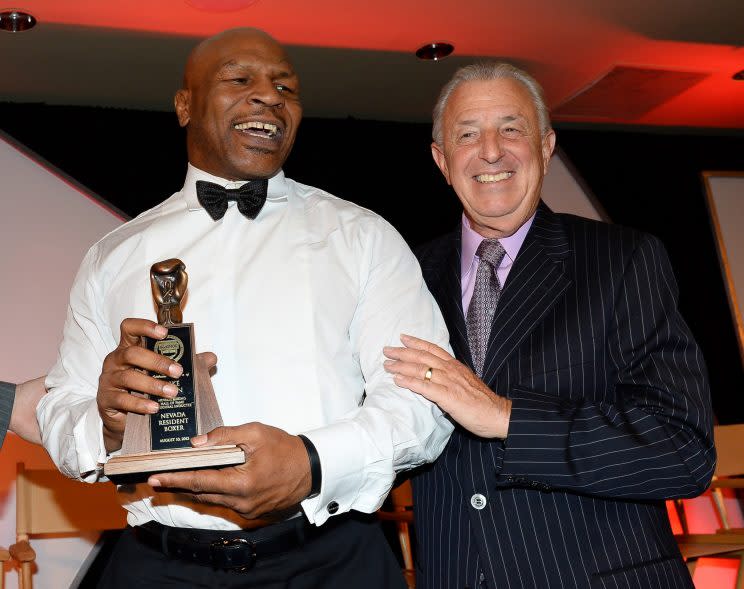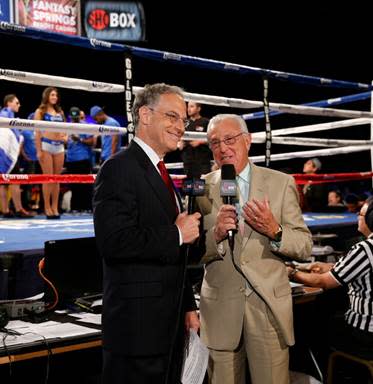Close friends Barry Tompkins, Steve Farhood, joyfully go into Hall of Fame as a team

The final 60 seconds of the middleweight title fight between Marvelous Marvin Hagler and Sugar Ray Leonard in Las Vegas on April 6, 1987, were riveting. As the final minute began, the crowd rose, chanting, “Sugar Ray! Sugar Ray!” as if to will the big underdog to victory.
With 10 seconds left, the announcer silent amid the crowd’s roars, the two men stood in a corner and exchanged blows to the head.
The bell rang to end the fight, the decibel level rising exponentially as the crowd celebrated the conclusion of a monumental event.
As the bell clanged, the announcer once again spoke.
“How do you like it?” he exclaimed. “How do you like it!?”
It sent chills down the spine of those who heard it in real time, and it still does to those who find the fight on YouTube and watch it again and again.
It would become perhaps the most iconic call in boxing history, as significant in the sport’s culture as Al Michaels’ call of the final seconds of Team USA’s upset over Russia in “The Miracle on Ice” is to hockey.
When he first head Barry Tompkins’ call, Steve Farhood was hardly surprised. Tompkins’ was one of the primary voices in boxing in the golden era of the 1980s, and he’d been known for his smooth delivery and seemingly perfect calls at the right moment.
Six months prior to Hagler-Leonard, Mike Tyson knocked out Trevor Berbick in the second round to become the youngest man to ever win the heavyweight title.
“It’s over. That’s all. And we have a new era in boxing,” Tompkins said.
“Barry’s call on that Leonard-Hagler fight was so perfect, so smooth and just fit the moment so well,” said Farhood, who at the time was the editor of KO Magazine. “He had a knack for that. He did the same thing at the Tyson-Berbick fight. He had the ability to come up with the right line at the exact right time.”
A little more than 30 years after that epic Tyson knockout, Tompkins and Farhood were reunited. They’re now broadcast partners on Showtime’s “ShoBox” series and have become close friends.
And on Tuesday, the International Boxing Hall of Fame announced the two as among the latest in its seven-man Class of 2017.
Each man knew a week or so prior to the official announcement on Tuesday by Hall president Ed Brophy. But the friends were sworn to secrecy, not allowed to say a word until Brophy himself released the news.
Farhood was elated, and wondered if Tompkins had been elected. Tompkins was thrilled, but questioned if Farhood had made it. The two became close after Showtime put them on the same crew, and each considered calling the other.
But the fear of the unknown prevented that.
“Steve is far more deserving of this than I am, he really is,” Tompkins said. “He’s one of those guys, he just knows more about boxing than anybody I’ve ever been around. Not only that, he’s one of the best people I’ve ever been around. He’s become one of my best friends, so to be going in with him is above and beyond. And when the announcement was made, I was happier for him than I was for myself.
“The other thing that was interesting about it is that the Hall of Fame called me last Tuesday (Nov. 29) to tell me. Right away, I thought to myself, ‘Well, do I call Steve?’ And I thought, if he doesn’t get in, I’m going to be devastated. So neither one of us called the other, thinking that perhaps the other didn’t get in. It wasn’t until straight up at 10 [Tuesday] morning that he called me and said, ‘Wow, you’re pretty good at keeping a secret.’ ”
The pair has worked together on “ShoBox” and become a model for how broadcast partners should work together. They’re never the show, but they constantly enhance the show with astute observations and perfectly timed calls.
Gordon Hall, the executive producer of “ShoBox,” brought Tompkins in and put him together with Farhood, who was an original on the crew when “ShoBox” debuted in 2001.
He was partnered with the late, great Nick Charles – It’s beyond time for Charles to be elected to the Hall of Fame, by the way, considering the grace, talent and passion he showed for his boxing broadcasts – at the start.
When Charles got the cancer that would eventually take his life, Showtime hurt Curt Menefee for a while to replace. Then, it was Bernardo Osuna and Mike Crispino.
All were good, but none fit with Farhood as smoothly as Tompkins.
“They work so well together and there are no egos at all,” Hall said. “We have a small crew on ‘ShoBox’ and we travel to these little towns around the country and we spend a lot of time together, and they make it so easy. It all works together so well, and it starts with them.
“We’ve been fortunate at Showtime in the last 25, 30 years to have some of the greatest announcers in boxing history. Al [Bernstein] is wonderful and is already in the Hall of Fame. Steve Albert, I’ve listened to so many of his calls, and he is just a tremendous broadcaster. And of course, Nick. Everyone loves Nick and loved what he did on the air. And then there are Barry and Steve. There aren’t two more professional, knowledgeable, class guys out there doing boxing.”
Farhood grew up in New York and wasn’t a particular boxing fan. But when he graduated from New York University with a degree in journalism, he was getting rejected for jobs.
There was tremendous competition in those days and it wasn’t easy to be hired.
Farhood took a job with Lonon Publishing, editing its boxing and pro wrestling magazines. Randy Gordon, the former head of the New York State Athletic Commission who now hosts a boxing talk show on Sirius/XM, was the editor at London Publishing.
When he told Farhood to do a pro wrestling story, Farhood was eager to get going, but he was new to wrestling and didn’t know where to begin.
“The first time they had me do a wrestling article, I asked, ‘Can you give me the number of the wrestler so I can call him to get some quotes?’ ” Farhood said. “They were like, ‘What? Call them for quotes? We save a lot of time around here by making them up.’ ”

Farhood soon became known for his work in boxing, and he quickly developed a passion for it. He began writing for KO and Ring Magazines and was hooked.
“I have been 24-7 boxing for almost four decades now,” Farhood said. “I never anticipated or wanted that when I was younger. Something like [being elected to the Hall of Fame] makes you look back, and when I look back, I feel like it was time well spent.
“I’ve enjoyed it and it’s a fascinating sport when you do what … I do. It never leaves you bored. It leaves you frustrated, and hurting sometimes, but never bored. There are so many great characters and people in this sport and it’s like every day is new and different and you really don’t have any idea of what might happen next.”
Tompkins can attest to that. The greatest fight he called, he said, is the classic super lightweight battle between Alexis Arguello and Aaron Pryor at the Orange Bowl in Miami.
He remembers it as much for what surrounded the fight as for the fight itself, which ranks high on the list among the greatest bouts in history.
Arguello was from Nicaragua and Gen. Manuel Noriega was in power at the time.
That was a point when there was a fierce battle between the Sandinistas, loyal to Noriega, and the Contras, whom Arguello supported.
Tensions were high that violence might erupt before, or during, the fight from supporters of the two sides.
“There was a lot of concern about what might happen, and they decided there weren’t going to be any fireworks, they weren’t going to sing the [national] anthems, any of that stuff,” Tompkins said.
Tompkins and HBO broadcast partners Larry Merchant and Sugar Ray Leonard were doing their pre-fight stand-up when Arguello began his walk to the ring.
All of the lights in the venue went out, save for one that shined on the broadcast crew. They were used to that, and then went about doing their jobs.
Unbeknownst to them, however, plans had changed. And in the darkened stadium, as Arguello was walking to the ring, with the only light focused on Tompkins, Merchant and Leonard, fireworks went off.
When the booms occurred, fans who thought shooting had broken out went diving for cover.
“There was only one light on in the whole place and it was on me,” Tompkins said. “All of a sudden, they shoot off the fireworks and we’re thinking we were about to be shot. It was a crazy night, but that went on to be one of the greatest fights ever, and it was a privilege to work it.”
They survived, fortunately, and Tompkins went on to become one of the best boxing play-by-play guys in history.
And now, at 76 and a lifetime of major fights to his credit, he’s as good as ever.
“You never think that one day, you’re going to be elected to the Hall of Fame,” Farhood said. “For me, it’s an incredible thrill. But what makes it better is going in with Barry. What a great broadcaster he is, not just in boxing, but in all sports. And he’s become such a good friend, that it’s so much better for me to be doing this with him. You couldn’t plan this any better than it’s worked out, honestly. It’s pretty remarkable, when you really think about it.”

 Yahoo Sports
Yahoo Sports 

